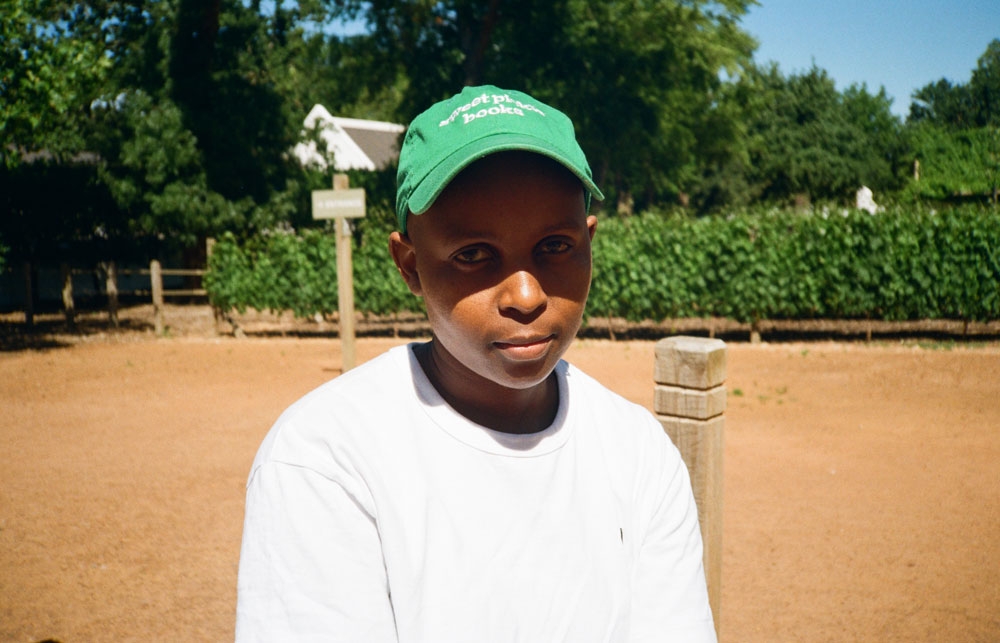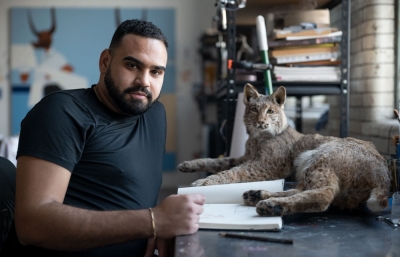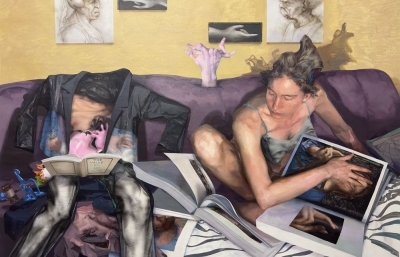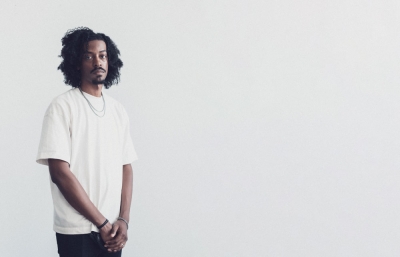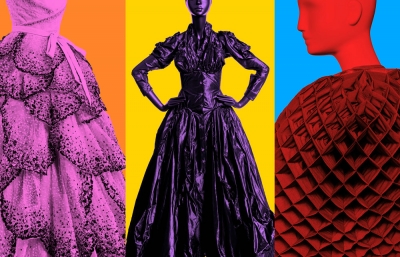The Dadaism of Dada Khanyisa
Cape Town's Taking Shape
Interview by Doug Gillen // Portrait by Qhawe Luthuli
Cape Town-based artist Dada Khanyisa isn't a Dadaist, so maybe the title here might be a little misleading. But as I thought about the work Khanyisa makes, a mix of politically astute and what is theorized as "going out culture but also going in culture,” I concluded that even if it's not Dadaism, it's Dadaisms.
Through paintings and collage assemblages, Khanyisa explores contemporary South African youth culture, in which everyday moments become reflections of the social, economic, and cultural structures of life throughout the country. The accentuated features of the work consist of various sculpted wood blocks, an effect that literally makes the paintings spring to life from the gallery walls. The characters also seem to jump into view, and like the great works of John Ahearn and Rigoberto Torres in NYC throughout the 1970s to the present, Khanyisa is virtually sculpting a history of the people around them. Painting often emanates permanency, but these works feel carved into history. —Evan Pricco

Doug Gillen: I actually read in one of your interviews that Western culture bores you. Is that true? That wasn't where I was planning to start, but please, I’m curious to know more.
Dada Khanyisa: One interesting thing about that was that I was six years younger, and I think I mentioned that I wasn't interested in traveling unless it was within the African continent. I think it's quite embarrassing now because I haven't visited any other African country. I've only been to the Western side of things, so I've had to dial that back. So I have to say sorry for saying that! I sometimes think about grand statements that outlive a feeling.
Did Western culture play a part in your life in South Africa when you were growing up, or was it really isolated to African or particularly South African influences that informed your cultural development?
What's interesting about South Africa is that, depending on where you stay or where you grew up, there's a balance. I’d say I grew up in a predominantly African landscape, but then through education, I became drawn closer to Western cultures because, even with art training, the program focuses a lot on the Western trajectory and the Western history of art. I really didn’t know much about what was going on in the greater continent, but I can tell you what is and was going on in the northern hemisphere and in the Americas. And I can actually articulate myself better in English than I can in my mother tongue.
What was it like growing up in Johannesburg? What was your relationship with art? Was it always part of your life, or did it come in at a later stage?
Joburg is similar to other cities in that there's a lot of public art, a lot of murals, and a lot of spray can art. So that was almost my introduction to art—what I saw while traveling or moving through the city. Joburg is so visually stimulating. It's a graffiti dominant city. But I would say I confidently stepped into an art gallery, became interested, and then went to pursue my fine art studies in Cape Town about 10 years ago.

How did the work on the street influence you?
There was a strip, a road, where you could see different kinds of murals that changed over time. I used to travel on that road daily, and I think that stimulated something in me and kind of pushed me towards studying animation. Seeing how things could change and bringing that to life.
Animation was the first career path that you thought you'd be following?
Yeah, that was the intention. I think it worked out better this way because there's still that kind of fun, playfulness in my work now. I know how to work with figures and model them because of that background of animation.
What kind of physical animations did you do? Stop motion, or was it digital stuff?
So the first step was very traditional and flat, and then we moved on to 3D programs. Then it was only when I moved to Cape Town that I focused on the sculptural and tactile elements.
I think that's why I started with animation because it felt like, okay, I could get a job. I was almost not a job person. And then, when I moved to Cape Town, there were more examples of people who were actually sustaining themselves through art. I mean, they had jobs. You have to have something that will keep the month to month bills handled, and all of it was within the margins of being an artist. You could be a lecturer, or you could be a tattoo artist. So I got to be around some examples of career artists moving to Cape Town. I consider Joburg to be the biggest marketplace in Africa because it's very Afrocentric. Then I consider Cape Town to be a gateway to the northern hemisphere, to the Western world. I think maybe that makes sense. I went from animation to more fine art in the move.

I visit Joburg for inspiration and research because that's where my social interests are. I go to Cape Town to regurgitate and put it all on a medium. You go to Joburg to party the whole weekend, but then it’s back to Cape Town and work for three months.
Paint a picture of when you're out on this sort of mission, trying to look for inspiration. Where do the people in your work come from? Are they scenes that you've made up in your head, taken from real life situations, friends, or are they strangers? Do you sketch them?
I try to mix the two, where imagination meets reality. What's tricky about referencing a person is that it's hard to get all their particulars right. Sometimes it's because of the style I use, which translates into a caricature
Intentionally?
No, no. It's like I'm highlighting someone's least favorite features. I've grown to lean more towards just imagination and allowing people to see who they think it is. It's easier that way than for me to refer to a real life person. But what I look for? I look for excitement. It's usually these social scenes with people out, hanging out, that I create. I call it happy hour culture.
I like that; describe happy hour culture.
I think it’s a time where there's saturation in the day, the golden hour. We have really nice sunsets in Cape Town, so I'm imagining a golden hour, a rooftop location, hopefully where they sell food, they have good cocktails, and it's a good time to meet with friends. It’s easy to draw inspiration from that.
But then, that culture is not as potent in Cape Town as it is in Joburg. It's an exciting city, Joburg. You are likely to come back to your home at 8 a.m. on those nights between Thursday and Sunday. The last few times I've been there, that's been the case. There's a level of excitement that I find in Joburg that I don't find in Cape Town. So that's where I really find my inspiration. I focus on sensuality, almost like the language between the characters, and I focus on location. A lot of social spaces have gone extinct or have changed in the last few years, so I think there's a part of my work where I try to create a memorial for what has been. And, of course, what is good now?

Then social commentary is inherent in your work. It seems, quite profoundly, that your work draws on emotion and social interaction.
Well, I think we are living in a very interesting time in history.
Sometimes it's a little too interesting. But you look for vitality.
There's that thing about sensuality. I find it very interesting that I’m modeling people in a way where they're so intertwined and connected. You don't know whose hand is holding whom. I enjoy that visual, like the visual language where people are smoking—almost like the audacity of youth.
South Africa is a dancing nation. I mean, even growing up, school kids were the ones that were kind of designing dance moves. And it's evident now, thanks to TikTok. It highlights how youth drives everything. The youth decide what's coming up next.
Do you think your work is distinctly South African?
I think so. I do think so. Maybe 75% South African, but then we are on the Internet nowadays, and all these influences we contribute to or take from the global community. There are certain terms that we adopt, all of us use, and whatever. I'd say it's South African with an influence of what's going on outside.
I try to include local items in my work, like clothing produced by designers who are locally-based. I think it's important as far as grounding the work in a location. I wouldn't say the people are particular or specific, but yeah, these are the people I'm around, and I'm interested in presenting a wider image of the people I have around. There's something I learned at art school where you cannot speak for or shouldn't speak for a demographic you don't belong to. There's that part where I'm like, okay, I'm not just exclusively around black people.

The thing that I noticed from your work was that the people aren't specific. They've all been altered in some way, so they're references to people you may have seen; they're not straight depictions. But the clothes are accurate, so I guess fashion is quite a big part of what interests you as a creative. I get a sense of streetwear culture being quite a big part of your cultural upbringing. What role, then, does fashion play for you?
I grew up collecting sneakers and was interested in them until I realized how my foot had stopped growing! But in the work, I think it's important that it's almost like a timestamp. You can trace it back to, “Oh, that's season 2019. That's the fall collection from this artist.”
Have you started to see your work age in that way? In the way that if I watch an old episode of Friends, it's just like how you start to see those fashions and that style start to change and be so much of a certain era. Have you started to notice that in your own work?
There was a time when I didn't, and I was just free with it. But when I'm consciously making something and I add a fashion detail, it reminds me that, oh yeah, that's a tee-shirt by someone who was canceled. That was a time when this person was celebrated, but I can't do that now.
We are in a time where you've got to be very careful with the choices that you're making when you're starting to reference certain people. It's a minefield out there.
It’s why I'm telling you about this phase where I was just leaning into my imagination and making things up because, in reality, things are very complicated. I can't make artwork based on an individual. I don't know how well their social profile is going to age.

But do you ever make work that's directly referencing a person?
Yes, and it's usually a process that includes me inviting them into the studio and taking photos. I start with a sketch to kind of direct them and guide them through. It's usually when I'm looking for very particular lighting on a face or speaking about someone, because sometimes I don't want to just depict someone's beauty. I mean, that's boring. You can see how beautiful they are on their Instagram profile, but there has to be something else. I usually work with people that have a history in performance, so I'd ask them to just play a role and record it, and there's a frame that will be suitable to blow up into a work of art.
I feel like your work is celebratory and joyful in nature. The characters feel so alive. Then, actually, when you sit and look at the characters in particular, none of them are smiling. Most of them barely even have their eyes open or are looking up. No one's looking directly at you. There's almost a certain sense of melancholy. To what extent do you agree with this observation? Is that sense of moodiness deliberately present, and if so, what role does that play for you?
So yes, it is true. There is a joyful element, and I think it goes back to the thing I said about happy hour culture. I guess the assumption is that when it's colorful and there are drinks on the table, we're all good. But then there's almost like a personality or a role that people tap into in those spaces. Cool people don't smile. There's an attitude about it, and that's why I've always tried to include someone with a cigarette. Or they’re almost so preoccupied with themselves that they don't entertain whoever's looking. It feels like a moment that's kind of like a stolen image. You could be somewhere, and you're like, “Those people look so cool,” and you secretly take a photo. I'm a voyeur. There’s a feeling that I'm looking from the outside-in, because my personality doesn't correlate with the cool crowd that much. I don't have that pompous-wearing-shades-indoors kind of attitude. I feel like I'm more open, and I'm likely to smile more in my work than the people who are my subjects.
I always try to figure out to what extent the artist is present in the work. Are these self-portraits masked in some way?
I feel like I play the role of a documentarian. I'm just like, “Hey guys, look at these people. I saw these people earlier. I just enjoyed their aura!” I think maybe it's what I referred to as the audacity of the youth, because I feel like I've lost it.
Since it's come back up, can you talk a little bit about what you mean by that?
I feel like the youth are quite audacious. A lot of people almost lose themselves when they are young and in pursuit of a particular lifestyle, and when it actually works, it's actually delightful to witness. I feel like there's a lot of that in Cape Town. It's a weird city because a lot of people are models. It was something that was very appealing to me when I moved here. I was like, Everyone is beautiful and youthful. There's a lot to write home about. A lot of people are good looking here. It's been my point of reference, and I'm almost trying to tell the world about it.
But then it's not an energy that only exists here. It's like anywhere you go, the youth are running shit. They're dictating how things are supposed to go. They're looking good in thrifted outfits, and so it's like they are so audacious and future focused, very forward and ahead.

What is it that you're working on at the moment, then?
I just had a solo show about my 10 years in Cape Town at the Johannesburg Art Gallery in Joburb. It was like an exercise to write home and say, “Hey, this is what I've been up to. This is what has been happening. This is what has happened over the last 10 years!” Now I just need time. I'm looking for a way to buy time to think and work in a way that is not machine-like, because sometimes the commercial art space puts you in that loop of forgetting that you love a narrative.
Dada Khanyisa’s Walkabout exhibition at the Johannesburg Art Gallery was on view in late 2023. This interview was originally published in our SPRING 2024 Quarterly.

